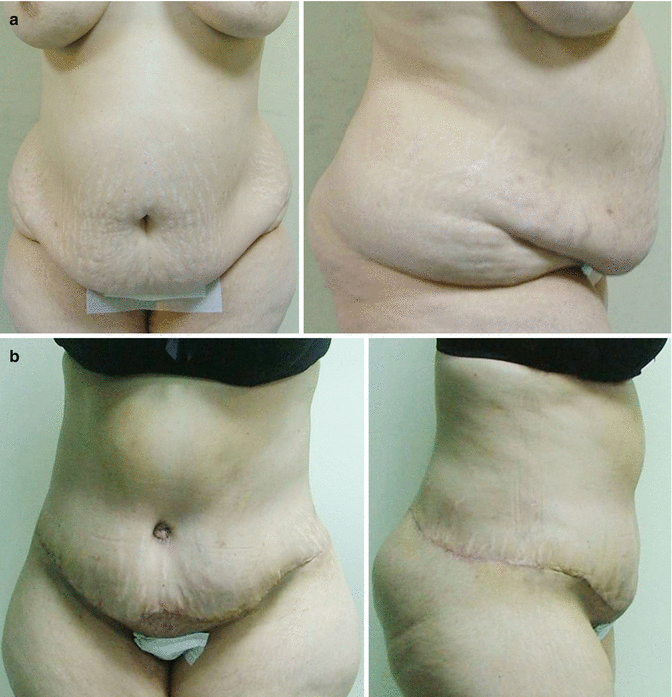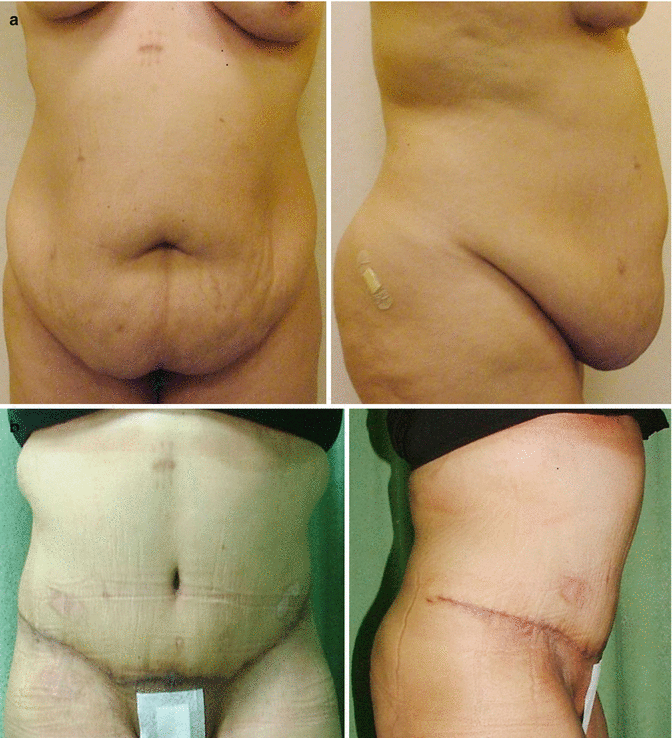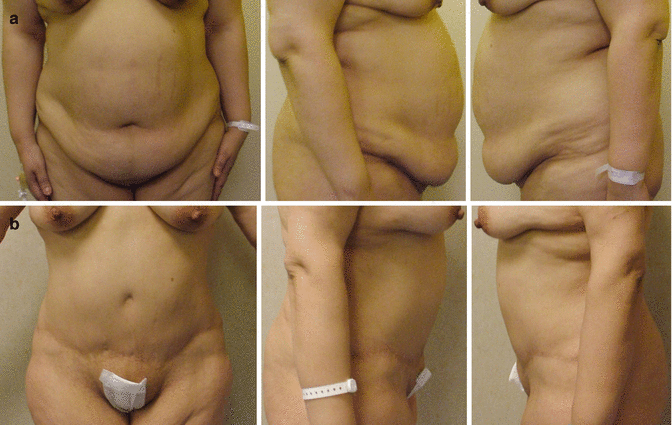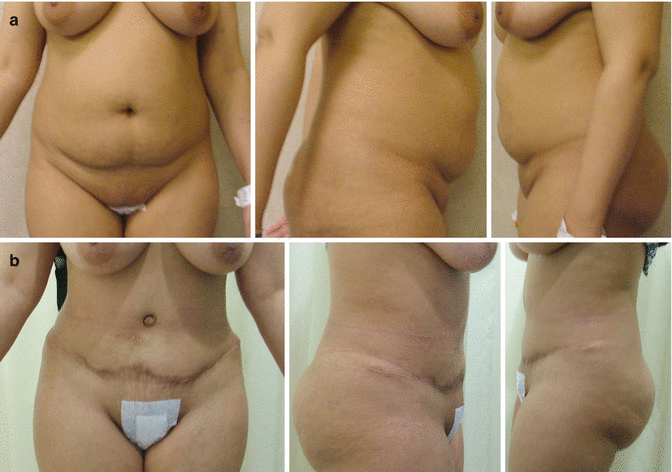Liposuction
Tissue removed
Flanks
Central
G I
1408.3 (SD, 540.1)
420.8 (SD, 184)
1225 (SD, 707.6)
G II
1208.3 (SD, 522.9)
416.6 (SD, 165.6)
1071 (SD, 652)
G III
1558.3 (SD, 531.6)
533.3 (SD, 162.8)
1231 (SD, 680.7)
20.4 Postoperative
The drains are removed initially after 3–4 days, but later on, it was preferred to remove drains after 1 week at least to avoid the incidence of seroma. Laser lipolysis delivers heat that causes extended fat loss, and therefore, drains are required for longer periods. Abdominal garment is used for 4–6 weeks. Oral antibiotics, analgesics, and anti-edema medications are used during the first week postoperative.
20.5 Surgical Outcome
20.5.1 Patient Assessment
The surgical outcome of laser lipoabdominoplasty is interpreted by evaluating two points; how much the technique can result in aesthetic improvement (effectiveness) (Tables 20.2 and 20.3). The other point is the incidence of associated complications and the degree of significance of these complications (safety) (Table 20.4). The aesthetic evaluation includes abdominal contour and skin tightness. In our work, we assess abdominal contour improvement based on an evaluation scale described by Salles et al. [25]. This scale takes grading from 0 to 10 depending on scar quality, umbilicus shape, central bulge, waist definition, and residual excess skin. In addition, the overall patient satisfaction for the aesthetic outcome of the abdomen shape is also assessed. Results can be graded upon this scale as excellent (>75 % improvement), good (50–75 % improvement), and fair (<50 % improvement). Skin tightness improvement can be assessed subjectively by overall patient satisfaction according to the quartile scale. Skin tightness improvement can be also objectively evaluated by comparing preoperative and postoperative measurements for the width of the supraumbilical stria.
Table 20.2
There is statistical significant improvement in abdominal wall contour in group II and group III in comparison to group I (p value p < 0.05)
Abdomen contour | |||
|---|---|---|---|
Fair | Good | Excellent | |
Group I | – | 12 | – |
Group II | – | 6 | 6 |
Group III | – | 4 | 8 |
G I: G II | Fisher’s exact p = 0.014 | ||
G I: G III | Fisher’s exact p = 0.001 | ||
G II: G III | Chi-square = 0.69 p = 0.4 | ||
Table 20.3
There is statistically highly significant improvement of both groups II and III in comparison to group I (p = 0.00)
Abdominal skin tightness | |||
|---|---|---|---|
Fair | Good | Excellent | |
Group I | 12 (100 %) | – | – |
Group II | 1 (8.3 %) | 11 (91.7 %) | – |
Group III | – | 3 (25 %) | 9 (75 %) |
G I: G II | Fisher’s exact p = 0.00 | ||
G I: G III | Chi-square = 24 p = 0.00 | ||
G II: G III | Chi-square = 14.6 p = 0.001 | ||
Table 20.4
Summary of incidence and degree of complications in all groups
Edema and indurations | Ecchymosis | Pain | Seroma | Skin necrosis | Wound dehiscence | Skin irregularities | Scarring | |
|---|---|---|---|---|---|---|---|---|
G: I | + | +++ | + | − | − | − | − | − |
G: II | ++ | ++ | + | − | − | − | + | + |
G: III | +++ | + | + | + | + | + | + | + |
20.5.2 Clinical Outcome
The authors [24] divided patients into three groups, 12 patients in each group based on the technique used for liposuction at different anatomical areas of the abdomen. Group I underwent conventional liposuction of the lateral and central upper abdomen. Group II underwent conventional liposuction of the central upper abdomen and laser-assisted liposuction of both flanks (lateral abdomen). The initial encouraging results in patients of G II allowed expanding the use of laser lipolysis in the central abdomen (in addition to lateral abdomen) in patients of group III aiming to achieve better aesthetic results.
In group I, the abdominal contour was good and skin tightness was fair in all patients (Tables 20.2 and 20.3). The decline in the supraumbilical stria width postoperatively was not clinically significant in all patients (nearly less than 10 %). Postoperative ecchymosis was severe in all cases and disappeared completely within 3 weeks. Edema and indurations were mild and faded by 10 days (Fig. 20.1).


Fig. 20.1
(a) Preoperative of a 35-year-old patient. (b) Postoperative following SAL and HLT abdominoplasty (group I)
In group II, the abdominal contour was good in 6 patients and excellent in 6 patients, whereas skin tightness was good in 11 patients and fair in 1 patient (Tables 20.2 and 20.3). There was about 20 % (ranged between 10 and 33 %) decline in the width of the supraumbilical stria measure (Figs. 20.2, 20.3, 20.4, and 20.5). Ecchymosis, edema, and indurations occurred in most of cases but within moderate degree. One patient in this group suffered from mild wound infection at the lateral wound edge; it healed conservatively resulting in mild scar and did not require surgical interference.








Fig. 20.2
(a) Preoperative patient. (b) Postoperative after HLT abdominoplasty, LAL of flanks, and SAL of central abdomen (group II)

Fig. 20.3
(a) Preoperative patient. (b) Postoperative after HLT abdominoplasty, LAL of flanks, and SAL of central abdomen (group II)

Fig. 20.4
(a) Preoperative patient. (b) Postoperative after HLT abdominoplasty, LAL of flanks, and SAL of central abdomen (group II)
Stay updated, free articles. Join our Telegram channel

Full access? Get Clinical Tree







